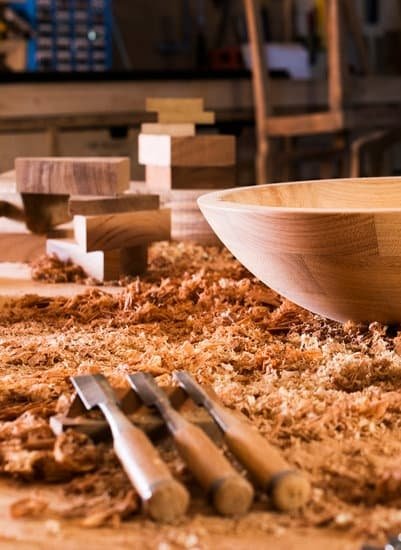What are reasons for round mallets for woodworking? When it comes to woodworking, having the right tools is essential, and the choice of mallet can make a significant difference in the outcome of a project. Mallets play a crucial role in woodworking, from shaping and carving to adjusting joints. In this article, we will delve into the reasons why round mallets are favored in woodworking and their unique benefits.
Woodworking enthusiasts often debate over various types of mallets, with some preferring round mallets for specific tasks. Understanding the design and function of round mallets will shed light on why they are valued by woodworkers. The ergonomic benefits, control and precision, versatility, impact and force distribution, as well as comfort and grip offered by round mallets set them apart from other shapes commonly used in woodworking.
In the following sections, we will explore in detail the advantages of using round mallets in woodworking while also comparing them with other shapes to better understand their significance. Whether you are just starting out or have years of experience in woodworking, understanding why round mallets are preferred can help enhance your craft and improve your overall woodworking experience.
What Are Round Mallets
Round mallets are essential tools for woodworking, particularly known for their efficient and effective use. These mallets come in a variety of shapes and sizes but the round design offers unique benefits that make them popular among woodworkers. Here are some key reasons why round mallets are commonly used in woodworking:
- Design and Function: Round mallets typically have a cylindrical head with a rounded striking surface. This design allows for even force distribution when striking a chisel or other woodworking tool, minimizing the risk of causing damage to delicate wood surfaces.
- Weight Distribution: The round shape of these mallets also facilitates better weight distribution, allowing woodworkers to exert controlled force without straining their wrists or hands.
- Stability and Precision: The rounded surface of the mallet head provides stability and precision during striking, enabling woodworkers to accurately control the direction and impact of their blows.
In addition to these features, the ergonomics of round mallets set them apart from other shapes. The cylindrical handle and rounded head allow for a comfortable grip and reduce hand strain during extended use. This ergonomic advantage makes round mallets an ideal choice for various woodworking tasks that require repetitive striking. Overall, the design and function of round mallets contribute significantly to their popularity among woodworkers due to their versatility, precision, and comfort.
In comparison to other shapes such as square or tapered mallets, round mallets offer distinct advantages that make them preferred tools in the woodworking trade. However, it is important to consider individual preferences and specific project requirements when selecting the most suitable type of mallet for woodworking purposes.
Ergonomic Benefits
Round mallets are a popular choice among woodworkers for several reasons. The ergonomic benefits of the round shape play a significant role in their preference. Here are some of the key reasons why round mallets are favored in woodworking:
1. Reduced Hand Strain: The round shape of mallets allows for a more natural and comfortable grip, reducing hand strain during prolonged use. This ergonomic advantage makes round mallets well-suited for tasks that require repetitive striking, minimizing the risk of fatigue and discomfort for woodworkers.
2. Balanced Weight Distribution: Round mallets are designed to distribute weight evenly across the tool, providing better balance and control during use. This balanced weight distribution contributes to improved handling and maneuverability, enhancing the overall user experience and minimizing the risk of accidental slippage or loss of control.
3. Enhanced Precision: The ergonomically designed round shape of mallets allows woodworkers to achieve greater precision in their striking actions. This precision is particularly beneficial when working on delicate or intricate woodworking projects that require careful and controlled hammering.
In addition to these ergonomic advantages, round mallets also offer versatility in various woodworking applications, making them a valuable tool in any woodworker’s toolkit. Whether shaping or assembling wood pieces, the ergonomic benefits of round mallets make them a practical and effective choice for woodworking professionals and enthusiasts alike.
Control and Precision
Round mallets are a popular choice for woodworking tasks due to several reasons, one of them being the better control and precision they offer. The round shape of mallets provides woodworkers with a comfortable and secure grip, allowing them to accurately aim and strike their target without worrying about slippage or discomfort. This aspect is particularly beneficial when working on delicate or intricate wood pieces that require precise handling.
In addition to offering a comfortable grip, the round shape of mallets enables woodworkers to have better control over the force and direction of their strikes. With a rounded head, the force is evenly distributed across the striking surface, preventing concentrated impact points that could potentially damage the wood. This results in more controlled and precise movements during woodworking tasks such as carving, mortising, or shaping wood pieces.
Furthermore, the round mallet design allows for greater maneuverability and accuracy when navigating tight spaces or hard-to-reach areas on wood projects. Woodworkers can easily adjust their hand position and angle of attack with a round mallet, giving them the flexibility to work on intricate details with ease. Overall, the control and precision provided by round mallets make them an essential tool for woodworkers who prioritize accuracy and finesse in their craft.
Versatility
Round mallets are an essential tool in woodworking, valued for their versatility in various woodworking applications. The round shape of these mallets provides several advantages that make them a valuable addition to any woodworker’s toolkit.
One of the primary reasons for using round mallets in woodworking is their ability to deliver a striking force without causing damage to delicate wood surfaces. The round shape distributes force evenly, minimizing the risk of denting or marring the material being worked on. This makes round mallets particularly well-suited for tasks that require precision and care, such as assembling joinery or carving intricate details.
Another reason for choosing round mallets for woodworking is their ergonomic design, which offers comfort and efficiency during extended use. The rounded handle allows for a natural grip that reduces hand strain and fatigue, enabling woodworkers to work with greater ease and accuracy. Additionally, the balanced weight distribution of round mallets makes them easier to control and maneuver, enhancing overall precision in woodworking tasks.
In addition to these benefits, round mallets are also highly versatile, making them suitable for a wide range of woodworking applications. From chisel work to assembling furniture joints, shaping wooden pieces, or even driving dowels and pegs into place, the rounded shape of these mallets ensures that they can be effectively utilized in diverse woodworking projects.
| Reasons for Round Mallets | Benefits |
|---|---|
| Even force distribution | Minimizes risk of damaging wood surfaces |
| Ergonomic design | Reduces hand strain and fatigue |
| Versatility | Suitable for a wide range of woodworking applications |
Impact and Force Distribution
Round mallets are a popular choice for woodworking due to their ability to distribute force evenly and minimize the risk of damaging wood surfaces. The round shape of these mallets ensures that the impact is spread out evenly across the surface, reducing the likelihood of dents or marks on the wood. This even distribution of force is especially beneficial when working with delicate or softer woods, where any uneven impact could result in visible damage.
The design of round mallets also allows for a more controlled and precise application of force. Woodworkers can accurately target specific areas without worrying about causing unintended damage. This precision is essential for tasks such as carving, chiseling, and joinery work, where accuracy is crucial to achieving a high-quality result.
In addition to minimizing the risk of damage, round mallets provide woodworkers with the assurance that they can apply significant force when needed without compromising the integrity of the material. The rounded surface spreads out the impact, ensuring that pressure is distributed evenly and effectively. This feature makes round mallets suitable for a wide range of woodworking applications, from assembling furniture joints to shaping intricate details on wooden pieces.
| Benefit | Description |
|---|---|
| Even Force Distribution | Minimizes risk of damaging wood surfaces |
| Precision | Allows accurate targeting and application of force |
| Ability to Apply Significant Force | Without compromising material integrity |
Comfort and Grip
When it comes to woodworking, the comfort and grip of the tools used are essential for ensuring a smooth and efficient work process. This is where the round mallet design shines, offering woodworkers a comfortable grip and reducing hand strain during extended use. Let’s explore how the unique design of round mallets provides these benefits.
Comfortable Grip
The round shape of mallets allows for a more natural and comfortable grip for woodworkers. Unlike square or rectangular mallets, which can cause discomfort and fatigue during prolonged use, the round design fits snugly in the palm of the hand, providing an ergonomic grip that minimizes strain. This comfortable grip not only enhances the overall woodworking experience but also contributes to better control and precision when using the mallet.
Reduced Hand Strain
Extended woodworking sessions can take a toll on a woodworker’s hands, leading to discomfort and strain. The round mallet design helps alleviate this issue by distributing force evenly across the hand, reducing pressure points and minimizing hand strain. This allows woodworkers to work for longer periods without experiencing as much fatigue or discomfort, ultimately improving productivity and efficiency in their craft.
Durability and Longevity
In addition to providing a comfortable grip and reducing hand strain, round mallets are often designed with durable materials that offer longevity despite frequent use. This means that woodworkers can rely on their round mallet to consistently provide comfort and reduce hand strain over time, making it a valuable tool in their woodworking arsenal.
Comparison With Other Shapes
When it comes to woodworking, the choice of mallet shape can significantly impact a woodworker’s efficiency and the quality of their work. In this section, we will compare round mallets with other shapes to highlight the unique benefits they offer in woodworking.
Round Mallets vs. Square Mallets
One of the primary differences between round mallets and square mallets lies in their impact on the wood surface. While square mallets may have more surface area for direct contact with the wood, they also tend to concentrate force in a smaller area, increasing the risk of denting or damaging the wood. On the other hand, round mallets evenly distribute force across their entire striking surface, minimizing the risk of surface damage while still providing adequate impact.
Round Mallets vs. Rubber Mallets
Rubber mallets have a softer striking surface compared to round wooden mallets, often making them a popular choice for delicate tasks or for working with materials that are sensitive to hard impacts. However, when it comes to woodworking tasks that require greater force and control, round wooden mallets offer superior precision and impact without compromising on durability or stability.
Round Mallets vs. Other Shapes
In comparison to other shapes such as cylindrical or tapered mallets, round mallets provide a balanced distribution of force without any sharp edges or corners that could unintentionally mark or dent wood surfaces. Additionally, their symmetrical design makes them easier to handle and maneuver during intricate woodworking tasks.
Conclusion
In conclusion, the round mallets for woodworking offer a multitude of benefits that make them an essential tool in any woodworker’s toolkit. The ergonomic advantages provided by the round shape, such as improved grip and comfort during extended use, make them a popular choice among woodworkers. Additionally, the control and precision offered by round mallets contribute to their appeal, allowing for more accurate and efficient woodworking tasks.
Furthermore, the versatility of round mallets in various woodworking applications cannot be overlooked. Whether it’s for chiseling, carving, or assembling joints, these mallets are proven to be reliable and efficient tools. Their ability to distribute force evenly and minimize the risk of damaging wood surfaces is another significant factor that makes them a preferred choice for woodworkers.
When comparing round mallets with other shapes, it becomes evident that their unique design sets them apart and reinforces their importance in a woodworker’s toolkit. Overall, the reasons for choosing round mallets for woodworking are clear – they offer ergonomic benefits, provide better control and precision, are versatile in various applications, distribute force evenly, and promote comfort and grip during use. With all these advantages considered, it’s no wonder why round mallets are essential tools for any woodworking enthusiast.
Frequently Asked Questions
Why Do Woodworkers Use Round Mallets?
Woodworkers use round mallets because the shape allows for a more balanced striking force when chiseling or carving wood. The rounded design helps to distribute the force evenly, preventing damage to the wood or tools.
What Are Wood Mallets Used For?
Wood mallets are primarily used in woodworking for tasks such as driving chisels, tapping joints together, or persuading stubborn wooden pieces into place. Their non-damaging striking surface makes them ideal for delicate woodworking tasks.
What Is the Best Wood for a Round Mallet?
The best wood for a round mallet is generally a dense hardwood like maple, hickory, or beech. These woods are sturdy and durable, able to withstand the repeated impacts of woodworking without deforming or splintering. Additionally, their tight grain structure ensures a smooth striking surface.

Hi everyone! I’m a woodworker and blogger, and this is my woodworking blog. In my blog, I share tips and tricks for woodworkers of all skill levels, as well as project ideas that you can try yourself.





